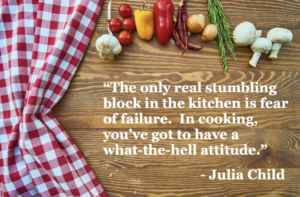 Does this sound familiar?
Does this sound familiar?
After a long crazy day, you are feeling pretty good about the plan for dinner. Sure, you only have a 30 minute window, but no problem, you’ve been to the store, have the recipe ready and everyone is geared up for a great-tasting meal!
As you are quickly and efficiently adding everything to the bowl, you jet to the pantry to grab the white wine vinegar. You are suddenly struck with reality…how are you out of white wine vinegar?!
How did that happen?! Now what do you do?! Is there something you can use instead, because you are NOT making a trip to the store!
If you do any amount of cooking, chances are this frustrating scenario has happened to you with some kind of ingredient. Based on requests from Eat REAL America members, we have put together a list of some common (and maybe some not-so-common) ingredient substitutions, so you don’t have to throw in the towel!
To keep this as manageable and useful as possible, we are dividing this up into separate coaching tips: the first focuses on liquids. Then, we will provide substitutions for herbs/spices.
Don’t panic!
One thing we had to learn is to be creative and not be afraid we would mess up the entire recipe! I still remember, when I was about thirteen, I was helping make meatloaf for our family’s dinner one night. My mom, still at work, reminded me of the ingredients, and I proceeded to make dinner. But I happened to grab the graham cracker crumbs instead of the breadcrumbs. Once I realized my mistake, I was ready to burst into tears and trash the whole meal! My grandparents were in town and I will never forget my grandma said, “we aren’t going to tell them and they will never know!” She was right…they all ate it and no one knew the difference!
So, don’t sweat it, don’t let substitutions intimidate you, and don’t be afraid to get creative! You might actually end up improving the recipe!
Alcohol
 Keep in mind, depending on the method of cooking, a significant amount of the alcohol will burn off at a temperature of 173 degrees Fahrenheit and especially in recipes with longer cooking times. So go ahead — wine and beer can add great flavor to lots of recipes and foods! For more helpful tips, check out our coaching tips on cooking with wine and beer. Of course, non-alcoholic versions can be used too.
Keep in mind, depending on the method of cooking, a significant amount of the alcohol will burn off at a temperature of 173 degrees Fahrenheit and especially in recipes with longer cooking times. So go ahead — wine and beer can add great flavor to lots of recipes and foods! For more helpful tips, check out our coaching tips on cooking with wine and beer. Of course, non-alcoholic versions can be used too.
Light beer or ale: chicken broth, ginger ale or white grape juice.
Dark beer or stout: beef, chicken or mushroom broth.
Hard cider: apple cider or apple juice.
Red wine:
- beef or chicken broth diluted with vinegar;
- red juice (such as grape, pomegranate or cranberry) diluted with vinegar. To dilute broth or juice, use 1 Tbsp of red wine vinegar, rice vinegar or balsamic vinegar per 1 cup of juice or broth.
- tomato juice;
- liquid from canned mushrooms.
White wine: chicken or vegetable broth; apple juice or white grape juice diluted with white wine vinegar (1 Tbsp of white wine vinegar in 1 cup juice or broth); or ginger ale.
Sherry: orange or pineapple juice, red wine vinegar, or apple cider vinegar.
Vinegars
 Vinegars are acidic liquids that are made from the fermentation of alcohol…or they can be made from other products like rice, fruit and grains. They do a great job enhancing colors of vegetables, pickling vegetables, tenderizing meat as part of a marinade, reducing bitterness, serving as an alternative to salt…and many other uses.
Vinegars are acidic liquids that are made from the fermentation of alcohol…or they can be made from other products like rice, fruit and grains. They do a great job enhancing colors of vegetables, pickling vegetables, tenderizing meat as part of a marinade, reducing bitterness, serving as an alternative to salt…and many other uses.
Apple cider vinegar (1 Tbsp) = 1 Tbsp lemon or lime juice
Balsamic vinegar (1 Tbsp) = 1 Tbsp apple cider vinegar or red wine vinegar + 1/2 tsp sugar. (Keep in mind, white balsamic and regular balsamic are interchangeable – the white version won’t darken your recipe.)
Champagne vinegar (1 Tbsp) = 1 Tbsp white wine vinegar or rice wine vinegar
Red wine vinegar (1 Tbsp) = 1 1/2 tsp white vinegar + 1 1/2 tsp red wine
Rice wine vinegar (1 Tbsp) = 1 Tbsp white wine vinegar or apple cider vinegar + 1/4 tsp sugar
White wine vinegar (1 Tbsp) = 1 Tbsp rice wine vinegar
Other cooking liquids
 Buttermilk (1 cup) = 1 Tbsp lemon juice or white vinegar + enough milk to make one cup. Combine and then let the mixture sit for about 5 minutes. You can also simply substitute 1 cup of plain yogurt for buttermilk.
Buttermilk (1 cup) = 1 Tbsp lemon juice or white vinegar + enough milk to make one cup. Combine and then let the mixture sit for about 5 minutes. You can also simply substitute 1 cup of plain yogurt for buttermilk.
Sour cream (1/4 cup) = 1/4 cup of plain nonfat Greek yogurt
Eggs – substitute with a “flax egg” when an egg is a moderate part of a recipe. Combine 1 Tbsp of ground flax seed with 3 Tbsp of warm water. Let sit for 10 minutes, and then add to your recipe. Keep in mind, flax eggs won’t work in every recipe, but work great in recipes such as Oatmeal Chocolate Chip Granola Bars. Try flax eggs and share your successes with us!
Fish sauce (1 tsp) = 1 tsp Worcestershire sauce or 1 tsp soy sauce
Hot pepper sauce/Hot sauce (1 tsp) = 3/4 tsp of cayenne + 1 tsp vinegar or, instead of the sauce, you can simply use 1/8 tsp cayenne or red pepper flakes
Lemon juice (1 Tbsp or half a lemon) = 1 Tbsp of lime or orange juice (half a lime or clementine orange) or 1 Tbsp of apple cider vinegar
Lime juice (1 Tbsp or half a lime) = 1 Tbsp lemon or orange juice (half a lemon or clementine orange)
Soy sauce: Any amount of soy sauce = 4 parts Worcestershire sauce + 1 part water
Worcestershire sauce (1 tsp) = 1 tsp soy sauce + dash of hot sauce or apple cider vinegar
Hoisin sauce (1/2 cup) = 1/2 cup of barbecue sauce + 1/2 tsp of Chinese five spice powder. Or, simply make your own homemade Hoisin sauce:
 1 tsp garlic powder
1 tsp garlic powder- 2 Tbsp rice wine vinegar
- 2 Tbsp honey
- 2 Tbsp ketchup
- 2 Tbsp low sodium soy sauce
- 1 tsp toasted sesame oil
- 1/4 tsp ground ginger
- 1/4 tsp crushed red pepper flakes
Enchilada sauce (this recipe to make your own enchilada sauce will make 15 oz or just under 2 cups):
 3 Tbsp olive oil
3 Tbsp olive oil- 3 Tbsp whole wheat flour (or gluten-free flour)
- 1 Tbsp chili powder
- 1 tsp ground cumin
- 1/2 tsp garlic powder
- 1/2 tsp onion powder
- 1 tsp dried oregano
- 1/4 tsp salt
- 1/4 tsp cayenne red pepper (OPTIONAL)
- 1 (8 oz) can tomato sauce
- 1 cup low sodium chicken broth (or vegetable broth)
- 1 tsp apple cider vinegar
- 1/4 tsp black pepper
First, have spices measured and ready in a small bowl. Then, add oil to a small saucepan over medium high heat. When hot, add flour and stir to combine. Add spices, stir again, and then add tomato sauce and broth. Stir until combined and let simmer 5-10 minutes until slightly thickened. Add vinegar and pepper and stir again, and then proceed to use in your recipe.
What has worked for you?
We would love to hear your ingredient substitution ideas!
Please share with us and we will share with other Eat REAL America members – we all need the help and ideas!
Just remember – don’t panic and keep cooking!
Print a PDF of this coaching tip for easy reference!
 LEARN MORE ABOUT THE NAPKIN!
LEARN MORE ABOUT THE NAPKIN!




Great ideas.! Thanks
This is going to be copied and hung on my refrigerator! During the pandemic, I’ve been having my groceries delivered but there are always a few things marked ‘out of stock’ so I then have the choice of either going shopping myself for those few things (which defeats the reason for grocery delivery) or being flexible and substituting other veggies or ingredients. This will be a big help!
We are so glad this is helpful! We just added a PDF link at the bottom of the coaching tip so you can easily print this and hang it up to reference! Thank you!
Got it! Thank you! Love Julia Child’s attitude, btw!
Julia Child does have the best quotes!
I love this article! Thank you for sharing. Great, helpful ideas … as usual! 🙂
I love this article! Thank you for sharing. Wonderful, helpful ideas … as usual! :). I will have to print this out as well!
We are so happy this is helpful – thank you!
I also love this, I usually stop and google but this is so helpful and useful, thanks for always keeping all the information right here on EAT. REAL!
I have been on this website for years and stumbled on this nugget of fantastic information! I love the .pdf that I can print off and have handy when I need to substitute an ingredient. Thanks, Krista!